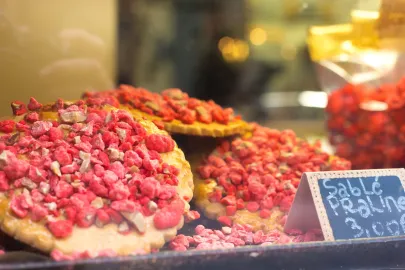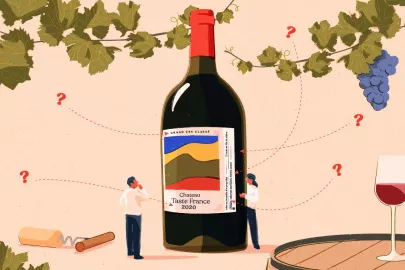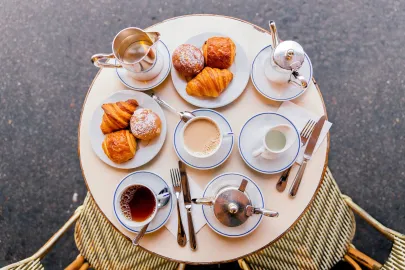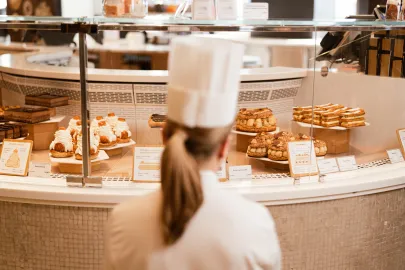London-based chef and author Alex Jackson, head chef at The Garden Museum, opens this edition of My French Madeleine by sharing the treasured moments that first bonded him to French food. Through intimate memories of aromas, places, and dishes, he reflects on how these experiences spark a lifelong love of French gastronomy.

My interest in the cooking of France started a long time ago. I’m from the distinctly unglamorous city of Birmingham – not considered one of the great food cities of the world – but luckily this was the era of the 90’s dinner party, and my Mum had a formidable cookbook collection. For us kids it was also the era of the summer holiday to the South of France – the Tarn region of the Languedoc, to be specific – and the start of an appreciation of that part of the world that has stayed with me. I remember our morning trips to the village boulangerie, and what was to a British sensibility an almost intoxicating smell of a hundred baguettes fresh out of the oven. I’d be made to order the bread in nervous French, and I suppose those were the first steps to studying French at university later on.
There was that children’s (and, admit it, adults’) favourite of steak haché, pink in the middle, and a now mythical roadside van, on some forgotten D-road, serving an absolutely blinding steak, chips and mustard on a paper plate, which we ate at a plastic table next to the car.
As part of my French degree at university, already a keen cook, I moved to Paris for a year – ostensibly to study, but realistically to drink rough red wine and try to chat up French girls. I lived in the 7ème, not far from École Militaire and the Eiffel Tower, where I shared a one-bedroom flat with a friend; not quite the glamorous situation you might imagine from the postcode. Before I lived in Paris, I had a vague idea that I liked French food, but by the time my year there as a student was over, there was no turning back. Paris is not the cheapest city, but if you know where to look, small, affordable (edible) luxuries are everywhere.
We didn’t have much money, but what we did have was time, and our daily ritual was to decamp to the cheapest of the local cafés, find a decent outward-facing table, order a coffee and watch the people go by with their shopping. This street (Rue Cler, if you’re asking) was the centre of our culinary universe. After sitting for a couple of hours drinking coffee, thoughts would turn to what was for lunch. We were spoilt for choice: here within a few hundred metres there were numerous boulangeries, four cheese shops, three butchers, six greengrocers and a couple of excellent delicatessens. In our favourite, the ‘Maison de Jambon’, as it was called, in the winter, a huge sign on the window: “Les truffes blanches d’Italie sont arrivées”. We didn’t have enough for white truffles, but we would buy fat slices of terrine de campagne instead.
Trooping around the shops we would buy some of the best produce Paris had to offer: a ripe Charentais melon and a few slices of cured ham; heavy, ruby-red tomatoes from the South, to be sliced thickly and eaten on toast slathered with salted butter. Green beans bought by the fistful from an enormous pile outside the grocers shop, boiled and simply dressed with butter and lemon, to eat with a whole rotisserie chicken from the shop next door, complete with potatoes splendidly sodden in the fat from the bird, and a punnet of the first Provençal gariguette strawberries for afters.
From the fromagerie we would buy little trays of delicious chèvre-lard, a devious invention: little goat’s cheeses wrapped in a slice of streaky bacon, to be fried up hot at home. The bacon crisped up and the molten cheese oozed out onto the plate, ready to be scooped up with the baguettes we had bought that morning. Once a week we would go to the market on the Avenue de Saxe, with the Eiffel Tower looming high at the end of the street and walk up and down inspecting the produce. A big bunch of spinach to go with some gnocchi, blue cheese and walnuts, eaten on a freezing cold night. Some impeccable baby squid and some taut fennel for a plate of orecchiette with breadcrumbs and herbs. Oysters and champagne to celebrate some small victory or other. Omelettes made with fudgy ends of raw milk goat’s cheese and fried potatoes. A ripe, raw milk Camembert de Normandie PDO, to stick with garlic, souse with white wine and bake, gloriously drunk, in the oven. Once, for a special occasion, we bought a whole leg of lamb from the posh butcher’s shop, and studded it with rosemary and garlic, to roast naked on a rack in the oven so that the juices drip onto sliced potatoes below. The butcher, bless him, sensed that I was out of my depth and gave me a discount (it still cost me 80 euros, a king’s ransom).
With the addition of an occasional casual meal out – inevitably at a restaurant with a tiny, one-man, everything-within-reach kitchen, checkered table cloths and a free Kir while you wait; followed by cold prawns and mayonnaise, gésiers en salade, duck confit with lentils, and a bottle of house red – it struck us how easy it was to eat very well for very little money, and we were determined to profit from it. We would shop and drink and chat and smoke and cook to our heart’s content, looking out of the window of my friend’s flat onto the streets around Les Invalides, watching Paris busy itself around us, we young men of leisure.
Here's a recipe for a dish that I cooked for the first time in Paris. We bought a whole rabbit from the market in the morning, and some excellent mustard from Dijon, and because we had never made Lapin à la Moutarde, we thought we would give it a try. We cooked it in one of those tiny electrical ovens that hangs off the wall, and it struck us that at that moment we were eating as well as anyone in the city might hope to. It was a year spent living well - if not quite like kings then certainly fat little princes.














